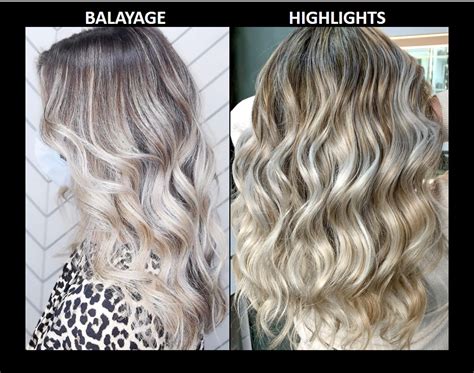Introduction
Coloring dark hair can be an art form, and choosing the right technique can elevate your look or leave you disappointed. Two popular options for adding dimension and vibrancy to dark hair are balayage and highlights. Both techniques offer distinct advantages and drawbacks, and understanding the differences between them is crucial for achieving your desired outcome.

Balayage: The Free-Handed Contouring Masterpiece
Balayage, a French word meaning “to sweep,” is a free-hand hair coloring technique that involves painting on lightener in soft, sweeping strokes. The result is a natural-looking, sun-kissed effect that mimics the way hair lightens naturally from the sun.
Key Features:
- Free-handed application: Balayage is applied by hand, allowing for precise placement of lightener.
- Subtle transitions: The gradual blending of lightener creates seamless transitions from darker roots to lighter tips.
- Low maintenance: Balayage is relatively low-maintenance compared to other coloring techniques, as it requires less frequent touch-ups.
Benefits:
- Natural-looking: The gradual transitions create a more natural-looking result that complements dark hair tones.
- Versatile: Balayage can be customized to suit your hair texture, length, and desired level of contrast.
- Damage-reducing: The free-hand application technique minimizes damage to the hair shaft.
Highlights: The Precision-Painted Brilliance
Highlights, on the other hand, involve applying lightener to specific sections of hair using foils or a cap. The result is a more defined, contrasting look that adds pops of brightness throughout the hair.
Key Features:
- Precise application: Highlights are applied using foils or a cap, which ensures even distribution of lightener.
- Striking contrast: Highlights create a more noticeable contrast between dark roots and lightened strands.
- High maintenance: Highlights typically require more frequent touch-ups than balayage, as the outgrowth becomes more visible over time.
Benefits:
- Dramatic effect: Highlights create a more dramatic and eye-catching look.
- Variety of options: Highlights come in a variety of sizes, placements, and shades, allowing for endless customization.
- Controllable results: The precise application technique gives you control over the intensity and distribution of the highlighted sections.
Determining the Best Technique for You
Choosing between balayage and highlights depends on your desired outcome, hair texture, and lifestyle.
Balayage is ideal if you:
- Prefer a natural-looking, sun-kissed effect
- Want low-maintenance color
- Have naturally dark hair
- Are looking for a damage-reducing technique
Highlights are ideal if you:
- Desire a more dramatic, contrasting look
- Want flexibility in customizing the placement and intensity of highlights
- Have time for more frequent touch-ups
- Are seeking a technique that can accommodate a variety of hair textures
Common Mistakes to Avoid
- Over-lightening: Bleaching dark hair too much can lead to breakage and damage.
- Inappropriate placement: Placing highlights too close to the roots can result in a harsh and unflattering look.
- Ignoring hair condition: Color-treated hair requires special care, such as regular conditioning and heat protection.
- Not consulting a professional: While both balayage and highlights can be performed at home, it’s highly recommended to seek the expertise of a trained colorist to ensure the best results.
How to Make an Informed Decision
Consider your motivations: Determine why you want to color your hair and what you hope to achieve.
Research the techniques: Thoroughly research balayage and highlights to understand the differences and benefits of each.
Consult a professional: Schedule a consultation with a colorist to discuss your desired outcome and hair condition. They can provide personalized recommendations and guide you towards the best technique for you.
Be patient: Achieving the perfect balayage or highlights can take multiple sessions, so be patient with the process.
Conclusion
Balayage and highlights are both popular coloring techniques that can transform your dark hair, but they offer distinct advantages and drawbacks. By understanding the key differences and considering your personal preferences, you can choose the technique that best meets your needs and creates the look you desire. Remember to consult a professional colorist for expert advice and to ensure the healthiest and most satisfying results.
